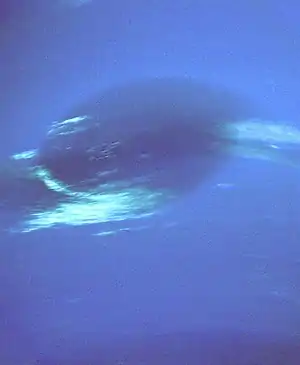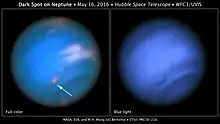Great Dark Spot
The Great Dark Spot (also known as GDS-89, for Great Dark Spot, 1989)[1] was one of a series of dark spots on Neptune similar in appearance to Jupiter's Great Red Spot. GDS-89 was the first Great Dark Spot on Neptune to be observed in 1989 by NASA's Voyager 2 spaceprobe. Like Jupiter's spot, Great Dark Spots are anticyclonic storms. However, their interiors are relatively cloud-free, and unlike Jupiter's spot, which has lasted for hundreds of years, their lifetimes appear to be shorter, forming and dissipating once every few years or so. Based on observations taken with Voyager 2 and since then with the Hubble Space Telescope, Neptune appears to spend somewhat more than half its time with a Great Dark Spot.

Characteristics
The dark, elliptically-shaped spot (with initial dimensions of 13,000 × 6,600 km, or 8,100 × 4,100 mi) of GDS-89 was about the same size as Earth, and was similar in general appearance to Jupiter's Great Red Spot. Around the edges of the storm, winds were measured blowing up to 2,100 kilometers per hour (1,300 mph), the fastest recorded in the Solar System.[2][3] The Great Dark Spot is thought to represent a hole in the methane cloud deck of Neptune. The spot was observed at different times with different sizes and shapes.
The Great Dark Spot generated large white clouds at or just below the tropopause layer[4] similar to high-altitude cirrus clouds found on Earth. Unlike the clouds on Earth, however, which are composed of crystals of ice, Neptune's cirrus clouds are made up of crystals of frozen methane. And while cirrus clouds usually form and then disperse within a period of a few hours, the clouds in the Great Dark Spot were still present after 36 hours, or two rotations of the planet.
Neptune's dark spots are thought to occur in the troposphere at lower altitudes than the brighter upper cloud deck features.[5] As they are stable features that can persist for several months, they are thought to be vortex structures.[6]
Disappearance

When the spot was to be photographed again in November 1994 by the Hubble Space Telescope, it had disappeared completely, leaving astronomers to believe that it has either been covered up or vanished. The persistence of companion clouds shows that some former dark spots may continue to exist as cyclones even though they are no longer visible as a dark feature. Dark spots may dissipate when they migrate too close to the equator, or possibly through some other unknown mechanisms.[8]
However, in 2016, an almost identical spot emerged in Neptune's northern hemisphere. This new spot, called the Northern Great Dark Spot (NGDS), has remained visible for several years.[9][10] It is unknown whether this spot is still present on the planet, as observations using the Hubble telescope are limited.[11] More recently, in 2018, a newer main dark spot and smaller dark spot were identified and studied.[12] In August 2020, the new Great Dark Spot suddenly stopped its southward motion and reversed direction, contrary to projections that the storm would continue to the equator, where it would have met its likely demise. Around the same time, a smaller "Dark Spot Jr." was found near the larger storm, before disappearing later on. This led astronomers to believe that the storm's reversal of motion may have been related to the birth of the smaller storm.[13]
See also
- Dragon Storm (astronomy)
- Extraterrestrial cyclone
- Great Red Spot, a similar storm on Jupiter
- Great White Spot, a similar storm on Saturn
- Oval BA
- Small Dark Spot
- Hypercane
References
- Hammel, H. B.; Lockwood, G. W.; Mills, J. R.; Barnet, C. D. (1995). "Hubble Space Telescope Imaging of Neptune's Cloud Structure in 1994". Science. 268 (5218): 1740–1742. Bibcode:1995Sci...268.1740H. doi:10.1126/science.268.5218.1740. PMID 17834994.
- "What is the Great Dark Spot?". Cool Cosmos. CalTech. Retrieved 20 May 2019.
- Suomi, V.E.; Limaye, S.S.; Johnson, D.R. (1991). "High Winds of Neptune: A possible mechanism". Science. 251 (4996): 929–32. Bibcode:1991Sci...251..929S. doi:10.1126/science.251.4996.929. PMID 17847386.
- Stratman, P. W.; Showman, A. P.; Dowling, T. E.; Sromovsky, L. A. (2001). "EPIC Simulations of Bright Companions to Neptune's Great Dark Spots" (PDF). Icarus. 151 (2): 275–285. Bibcode:1998Icar..132..239L. doi:10.1006/icar.1998.5918. Retrieved 2008-02-26.
- Gibbard, S. G.; de Pater, I.; Roe, H. G.; Martin, S.; Macintosh, B. A.; Max, C. E. (2003). "The altitude of Neptune cloud features from high-spatial-resolution near-infrared spectra" (PDF). Icarus. 166 (2): 359–374. Bibcode:2003Icar..166..359G. doi:10.1016/j.icarus.2003.07.006. Archived from the original (PDF) on 2012-02-20. Retrieved 2008-02-26.
- Max, C. E.; Macintosh, B. A.; Gibbard, S. G.; Gavel, D. T.; Roe, H. G.; de Pater, I.; Ghez, A. M.; Acton, D. S.; et al. (2003). "Cloud Structures on Neptune Observed with Keck Telescope Adaptive Optics". The Astronomical Journal. 125 (1): 364–375. Bibcode:2003AJ....125..364M. doi:10.1086/344943.
- "Dark spot on Neptune". Retrieved 28 June 2016.
- Sromovsky, L. A.; Fry, P. M.; Dowling, T. E.; Baines, K. H. (2000). "The unusual dynamics of new dark spots on Neptune". Bulletin of the American Astronomical Society. 32: 1005. Bibcode:2000DPS....32.0903S.
- "Neptune". SolarViews.com. Retrieved 2011-09-28.
- "Hubble Discovers New Dark Spot on Neptune". newscenter. Retrieved 2016-02-04.
- "Dark Spots in Our Knowledge of Neptune". nytimes. Retrieved 2016-02-04.
- Stirone, Shannon (22 December 2020). "Neptune's Weird Dark Spot Just Got Weirder - While observing the planet's large inky storm, astronomers spotted a smaller vortex they named Dark Spot Jr". The New York Times. Retrieved 22 December 2020.
- Michael H. Wong; Amy Simon (15 December 2020). "Dark Storm on Neptune Reverses Direction, Possibly Shedding Fragment". Hubblesite. Retrieved 25 December 2020.
External links
| Wikimedia Commons has media related to Great Dark Spot. |
- Neptune's Great Dark Spot of 1989, Windows to the Universe
- Neptune's Great Dark Spot: Gone But Not Forgotten, Astronomy Picture of the Day, May 8, 1996
_flatten_crop.jpg.webp)